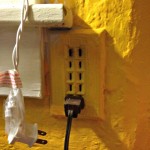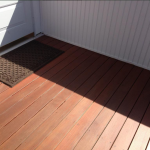Welcome to a new feature on House & Hammer, where we explore some of the quirky features found in old homes -- what they are, the history and purpose behind them, and…

The sweet spot: How long can you go between turning off the heat and turning on the A/C?
Disclosure: This post is sponsored by Choose Energy, an online marketplace where consumers can compare rates from electricity and natural gas suppliers. I’m a member of their compensated blogger program; however, all opinions expressed here are my own.
Here in New England, we spend a lot of time battling the elements. If Mother Nature isn’t blowing snow in our faces at 50 mph, she’s making us spew sweat like burgers on the barbecue at her Fourth of July cookout. But we live for those perfect, temperate sweet spots in between — from early September to mid-October, and late April until mid-June — when the temperature is finally, mercifully, just right.
You don’t need a jacket, but you don’t need to break out the flip-flops. It’s perfect hoodie weather.
In fact, for about a month or more, you don’t need the heat on — and you don’t need the air conditioner, either. And heating and cooling accounts for almost half of the average home energy bill, so every day you’re not paying for one or the other is helping the earth and saving you money on electricity.
So, this spring, I offer you a challenge: How many consecutive days can you go between turning your heat off… and turning the A/C on?
We are, of course, champions at this game, because for a few years there we didn’t have any air conditioning to speak of. Once our daughter came along, though, we put in a couple of window units, so as not to inadvertently cook our child.
Still, we really only use them when the mercury tops about 88 degrees; anything under that, and we can usually get away with our au natural AC. Here’s how we do it:
Step 1: Open all the windows at night. On all but the hottest summer days in Boston — I’m talking 99 and 100 degrees, ugh — the temperature drops into the low 70s or 60s by the wee hours of the morning. We’re in a pretty breezy spot, a few blocks from the ocean, so that cool air blows right into our house all night, leaving it all cooled off by morning.
Step 2: Use box or ceiling fans. Of course, a little added oomph doesn’t hurt. Using fans to circulate the air will draw in more of that cool night air and keep you cooler in bed, too. (We used to use box fans for this, but ceiling fans have been a life-changer.)
Step 3: Close windows and curtains by mid-morning. The final step is to trap all that cool night air inside, and prevent the sun from streaming in your windows like a greenhouse. By about 9 a.m., it starts getting pretty hot outside and the sun’s rays are getting stronger. Make sure you batten down the hatches to stay cool all day.
When we use that strategy, we can keep our house in the 70s on all but the hottest days of the summer. If the sun is really beating down on the house in the afternoon, it’ll creep up into the 80s by early evening, and we’ll turn on the AC for an hour or two just to give us some relief. I don’t want to sleep in a sauna.
This may not work for those of you who, like my brother, want to be downright cold in the summer. ( I think he enjoys picking fights with nature, as he actually keeps his thermostat higher in winter than in summer.) But most people would agree that a temp in the mid- to high-70s is pretty ideal, right? Isn’t that the whole appeal of Southern California?
I should add that I’m not some heat-loving weirdo. I LOATHE being hot. I sweat like a demon and I hate every minute of it. I wish it were colder here all year round, and I wouldn’t move anywhere with even a slightly warmer climate than Boston’s.
But, here’s the thing: When we keep the temperature cool naturally, I’m much less likely to become a dripping, sweaty mess for some reason. I think my body better adjusts to the climate and is able to regulate itself better when it’s not cycling through extreme heat and humidity and extreme cold.
There is some science to back this up — what matters in terms of personal comfort is not our actual temperature as much as our perception of it. “The human body and human skin is not like a thermometer,” MIT grad Sam Shames told Wired magazine. “If I put something cold directly on your body at a constant temperature, the body acclimates and no longer perceives it as cold.” Shames is working on a wristband called Wristify that can effectively regulate your body temperature with simple bursts of hot or cold. (Genius!)
Anyway, once this cold spell breaks in a week or so and the nights stop dipping into the 30s, we’re going to try and stay heat- and AC-free until…. well, probably the first 90-degree day of summer.
Think you can beat us? How many days can you go without heat or A/C this spring? Share your strategy — and your streak — in the comments!



